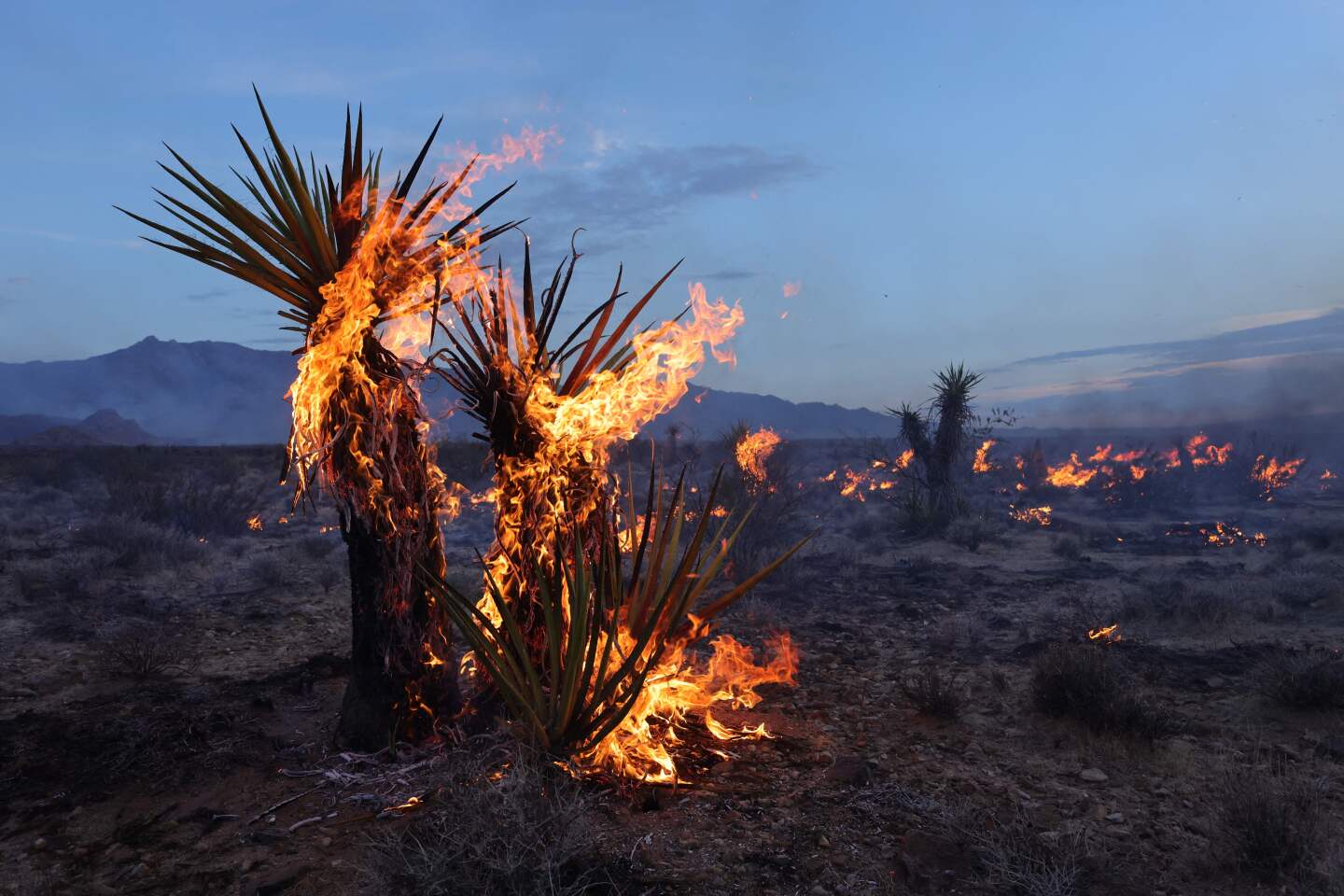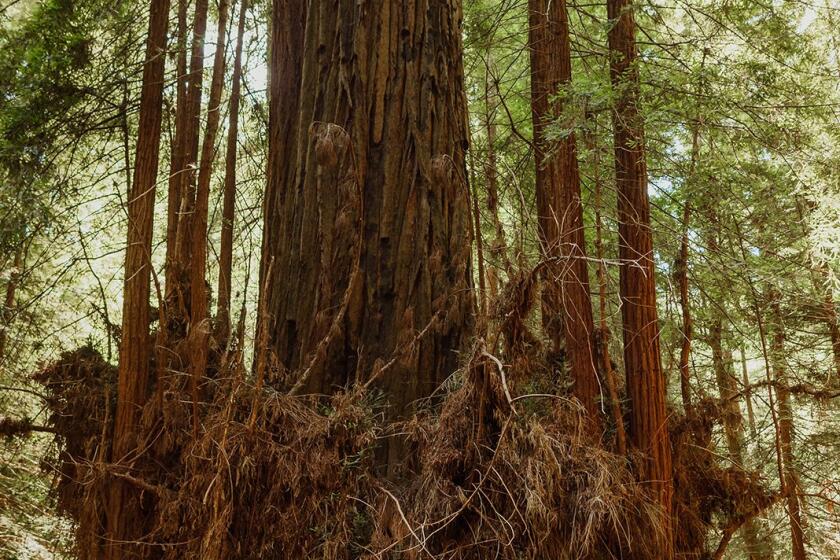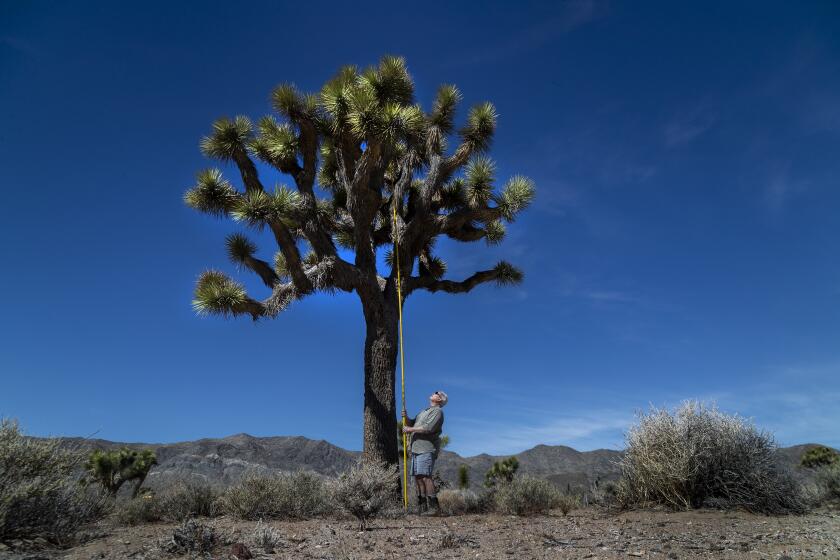California’s famed Joshua trees are burning up fast. They might be impossible to replace
- Share via
A light rain fell on the Mojave National Preserve, where firefighters continued their nearly weeklong battle Wednesday against an unusual desert wildfire that has incinerated countless Joshua trees and threatens to forever alter California’s high desert landscape.
Crews were aided by the arrival of monsoonal moisture, which brought some rain and humidity that helped slow the spread of the 82,000-acre York fire, which was about 30% contained Wednesday.
But in many ways, the damage has already been done. The fire is the largest to burn through the eastern Mojave in recorded history, surpassing the 71,000-acre Hackberry complex fire of 2005 and searing through a delicate ecosystem already strained by invasive species and the burning of fossil fuels.
“The reality is that Joshua trees are already in a state of decline because of global warming and increasing frequency of drought,” said James Cornett, an ecologist who specializes in the species. “And then on top of that, you throw on a fire like the York fire, and these trees are not likely to recover in our lifetime.”
“In fact, I can say with the utmost certainty that the areas that burn — whether it’s Joshua trees or other plants — will never look the same in the next couple of generations, if not longer,” he said.
As firefighters finally made progress on California’s largest wildfire of the year, national park officials and ecologists are preparing for irreversible habitat losses.
Although park biologists will begin to survey the damage once the flames subside, the exact number of Joshua trees lost to the York fire will probably never be known because there have been no prior surveys. And it’s hard to count ash, said Debra Hughson, deputy superintendent of the Mojave National Preserve.
“They go up like they’re soaked in diesel fuel,” she said. “They burn real well.”
What is clear, however, is that like much of California, the desert region has undergone significant changes in recent years, due largely to human activity.
In the past, occasional lightning-sparked fires might have burned a few Joshua trees, but those blazes would typically stay pretty small because there was little fuel to carry flames from one sparse clump of trees to the next, said Chris Clarke, associate director of the California Desert Program with the National Parks Conservation Assn.
Now, the fires are fed by invasive species such as cheat grass, Mediterranean split grass and Sahara mustard that litter the desert floor. In some cases, the grasses were deliberately planted as ornamental fixtures in nearby areas, but others arrived as contaminants from grain crops and feed for cattle.
The grass fire cycle is “deleterious for all the desert species except the grass, pretty much,” Clarke said.
And this year’s wet winter only helped to accelerate underbrush growth, creating a perfect storm for the dangerous desert fire.
“We’re hoping that it’s a low-intensity patchwork of fire — and that there’s going to be islands within the fire footprint that are unaffected or only lightly affected — but the fact is that with very few exceptions, the desert landscape did not evolve in the presence of large fires,” he said.
Save the Redwoods League hopes to raise $6.5 million to buy and preserve 394 acres in Sonoma County, including an ancient redwood called the Clar Tree.
Joshua trees are unique to the Southwestern United States, with the majority of their population located in California. But not even the desert-adapted trees are immune to climate change, which experts say is making it harder for young trees to become established.
Even when humans try to help foster regrowth of burned or damaged Joshua trees, it’s a long, fraught process, said Ashley Hemmers, a tribal administrator for the Fort Mojave Tribe, whose ancestors have lived for centuries in the region.
“It’s a slow-growth tree,” Hemmers said, noting the species lives up to 200 years. “Even if we were to revitalize and restore, which we do ... we won’t see the fruits of that for a whole lifetime — if we’re even able to.”
Last month — acting partly on concerns from conservationists that the species could lose 90% of its range by 2100 — the state enacted the Western Joshua Tree Conservation Act, the first law aimed at helping to ensure the trees’ survival.
California has enacted the Western Joshua Tree Conservation Act, which is aimed at helping to ensure the survival of millions of the climate-threatened trees.
No such protections exist for the eastern range of the species, which is generally believed to be less threatened than its western counterpart. But fire can upend everything, Clarke said, noting that the eastern range is less adapted to blazes than the western one.
For evidence, he pointed to the Dome fire of 2020, which seared through more than a quarter of the Cima Dome Joshua tree forest in the Mojave National Preserve. The high-intensity fire saw 30-foot flame lengths and fire whirls not unlike those observed in the York fire, and ultimately burned about 1.3 million trees — fewer than 10% of which have since resprouted.
“The tops of trees often get singed pretty badly, even in low-intensity fire,” Clarke said. “If that’s the only damage that happens, there’s a pretty good chance of resprouting. If it’s a really high-intensity fire and it does damage the roots of the trees, then they probably won’t come back.”
As firefighters finally made progress on California’s largest wildfire of the year, national park officials and ecologists are preparing for irreversible habitat losses.
Indeed, history has shown that it’s extremely difficult to restore lost Joshua trees.
The literature on vegetation restoration in the Mojave Desert “is a tale of failed experiments,” Hughson said, noting that recovery efforts to replant Joshua trees after the Dome fire had not been particularly successful.
Teams there have focused their replanting in high-elevation areas, where Joshua trees are likely to have a better chance at survival as global warming makes the desert climate even harsher. But officials say the once-full forests will probably never return.
“The real challenge with Joshua trees [is] all those forests we see out there — in Joshua Tree National Park or Mojave National Preserve — those forests evolved when the giant ground sloth was still present in North America,” said Sierra Willoughby, supervisory park ranger for the Mojave National Preserve.
Ecologist Jim Cornett is as fascinated with California’s driest places as ever. But the signs of stress brought on by climate change terrify him.
That sloth, extinct for about 10,000 years, was once the primary organism that helped spread Joshua tree seeds, through their dung.
“These are like relic forests. The only things spreading seeds now are like pack rats and other rodents,” Willoughby said, noting that smaller animals don’t spread seeds nearly as widely as the giant ground sloth once did.
For the record:
9:26 a.m. Aug. 3, 2023An earlier version of this article misspelled the last name of retired conservation ecologist Cameron Barrows as Barrow.
Cameron Barrows, a retired conservation ecologist who still researches climate change with UC Riverside, called the Joshua tree a “keystone species.” Without it , dozens of insects, birds, lizards, snakes and other creatures wouldn’t survive in the harsh environment.
“You pull that keystone out, and many, many species are affected,” Barrows said. “You lose the biodiversity of the desert.”
Even without fires, Barrows said, it’s increasingly rare to see baby or juvenile Joshua trees, as they haven’t grown their full defense against drought, especially severe drought that has plagued the region for the last few years.
“The babies aren’t able to survive,” Barrows said. “It’s very difficult to reestablish a healthy stand of Joshua trees once they have died.”
Death Valley, one of the most extreme places on the planet, is already seeing the impact of climate change, with summers even hotter than usual.
Already, a small portion of the fire has spread from California into the newly established Avi Kwa Ame National Monument in Nevada.
Officials have been monitoring the fire’s movement onto the land, considered sacred for many Native American tribes, as flames near the Wee Thump Joshua Tree Wilderness — one of the densest Joshua tree forests in the world. Nevada forestry officials said Tuesday that the fire’s footprint was about six miles from that grove.
The flames’ movement into the area appears to have stalled, but damage to that forest would have a domino effect on the local environment, said Hemmers, the Fort Mojave Tribe administrator, whose people claim the monument’s land as ancestral homelands.
She noted that the trees are important shelter and habitat for species like the golden eagle, other raptors and even the threatened desert tortoise.
“The ecosystems out here are very fragile,” Hemmers said. “What’s going to happen to these animals if these homes are gone, especially in an already barren landscape?”
Even if the fire doesn’t reach that particular Nevada grove — home to the state’s largest known Joshua tree — Hemmers said the burn scar from a fire this massive will undoubtedly have reverberating effects.
“Having more burn area means it’s going to be an even more formidable place for these animals to inhabit,” from desert big horn sheep to birds, Hemmers said.
Cornett, the ecologist, feared that such a bleak outcome was all but unavoidable in today’s changing world.
“It’s a very tenuous existence under normal circumstances, but under circumstances where we have increasing temperatures and increasing frequency and intensity of drought — they just can’t do it,” he said of the trees. “It’s beyond their physiological capabilities to compensate for these new burdens. And of course fire is the most dramatic burden that they’re facing now.”
More to Read
Sign up for Essential California
The most important California stories and recommendations in your inbox every morning.
You may occasionally receive promotional content from the Los Angeles Times.





















